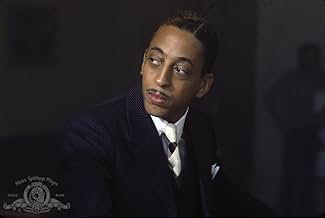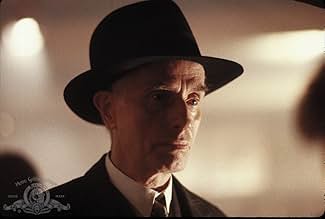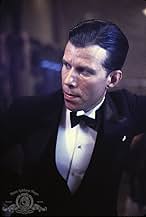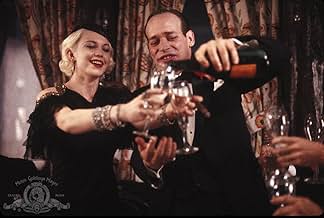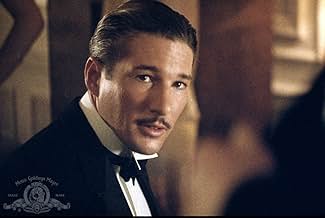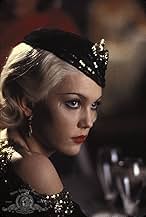VALUTAZIONE IMDb
6,6/10
20.525
LA TUA VALUTAZIONE
Il Cotton Club era un famoso nightclub di Harlem. Questa è la storia delle persone che hanno visitato questo club e delle persone che lo hanno gestito.Il Cotton Club era un famoso nightclub di Harlem. Questa è la storia delle persone che hanno visitato questo club e delle persone che lo hanno gestito.Il Cotton Club era un famoso nightclub di Harlem. Questa è la storia delle persone che hanno visitato questo club e delle persone che lo hanno gestito.
- Regia
- Sceneggiatura
- Star
- Candidato a 2 Oscar
- 1 vittoria e 9 candidature totali
Laurence Fishburne
- Bumpy Rhodes
- (as Larry Fishburne)
John P. Ryan
- Joe Flynn
- (as John Ryan)
Recensioni in evidenza
inspired by photographs of the legendary Cotton Club in Harlem, some shots appear exactly as they were (now in colour). I noticed Dutch Schultz's slumped pose when he is shot is exactly that of the police photograph, though he died several hours later (see William Burroughs "The Last Words Of Dutch Schultz"). The actors often play too broad (Diane Lane), and Richard Gere shows his lazy, grinning acting here too. However, many notable smaller roles for Gregory Hines (and his brother), Bob Hoskins, Laurence Fishburne and others who make it well worth watching. It is true that $40 million could have been used better, but when you consider both Bob Evans and Coppola's involvement it seems with hindsight that they were asking for trouble. The music deserves special credit, as do the tap sequences (which i gather were shortened and some cut - what a shame). Mostly Duke Ellington classics. As i've already suggested the look is a perfect recreation of the time, but sadly the plot is patchy, some dialogue weak and it has been said before - there is no chemistry between the romantic leads. 9/10
This is a great movie. I personally don't think the beautiful Diane Lane could be in a bad flick, she would make the worst one good. I was impressed with Richard Geres musical ability as he played his own coronet and sounded as good as anyone I've ever heard. The dancing was superb, the costumes beautiful and the plot authentic. It took me back to the great musicals of the forties and fifties. I was raised in the waning days of the era of this movie, the thirties, and I could almost hear my Dad talking about the evils of the big cities while we listened to the radio news of gangsters and shootouts. I would recommend this movie to anyone. I rate it 10/10.
One gets the sense that 'The Cotton Club (1984)' will improve upon repeat viewings, once you've become accustomed to what director Francis Ford Coppola was attempting. After all, this is a gangster film from the man who brought us 'The Godfather (1972)' and its sequels – what else could we expect but another Corleone saga? The film we're delivered is nothing of the sort, a testament to the director's constant willingness to take risks and experiment with new ideas. Indeed, rather than trying to emulate Coppola's former successes, 'The Cotton Club' could more accurately be described as a "gangster musical," a realisation that took me until the film's second half. Do those two genres even go together? Perhaps taking inspiration from Herbert Ross' 'Pennies from Heaven (1981)' – and the mini-series on which it was based – the film blends the ugly brutality and corruption of the Prohibition- era with the dazzling bright lights of the Cotton Club, Harlem's premiere night club. It is this deliberate but uneasy juxtaposition of reality and fantasy that fuels Coppola's vision, an ambitious undertaking without a dominant focus.
The film's major storyline concerns Dixie Dwyer (Richard Gere), a comparatively ordinary jazz musician who unexpectedly finds himself associating with organised crime boss "Dutch" Schultz (James Remar). Dixie is interesting because, unlike your typical hero consumed by the allure of amoral riches, he always remains peripheral to the world of gangsters; he observes, with disapproval, its dishonesty and depravity, but rarely finds himself a part of it. In fact, the closest he ever comes to being a gangster is in Hollywood, where he shares the sort of film roles that made James Cagney and Edward G. Robinson famous. Coppola might have been offering a commentary on the inherently romanticised version of reality offered by the movies, but his "real world" of gangsters is scarcely less stylised. The seedy underbelly of organised crime is paradoxically depicted as taking place in the classiest locales in Harlem, where the crime bosses consume the best alcohol and mix with Hollywood's elite talent (Chaplin, Swanson and Cagney among the featured patrons).
Proving further that Coppola wasn't attempting to replicate his Corleone saga, 'The Cotton Club' also features a rather extraneous subplot with Maurice and Gregory Hines as African-American tap-dancers vying for the "big-time" at the Cotton Club, where (in a bizarre discriminatory switch) only black performers are hired. The regular cross-cutting between this story and Dixie Dwyer's doesn't quite work, and, in any case, the taut romance between Dwyer and tough-girl Vera (an absolutely gorgeous Diane Lane) is much more involving than that between Sandman Williams (Gregory Hines) and mixed-race dancer Lila (Lonette McKee). Among the film's impressive supporting performers are Bob Hoskins and Fred Gwynne as crime associates, Nicholas Cage as an overly-ambitious young thug, Laurence Fishburne as black crime boss Bumpy Rhodes, and James Remar, playing a sleazier and less identifiable version of Dutch Schultz to Dustin Hoffman in 'Billy Bathgate (1991).' The premiere gangster film of 1984 was Leone's 'Once Upon a Time in America (1984),' but, despite being runner-up, nobody can accuse Coppola of playing it safe.
The film's major storyline concerns Dixie Dwyer (Richard Gere), a comparatively ordinary jazz musician who unexpectedly finds himself associating with organised crime boss "Dutch" Schultz (James Remar). Dixie is interesting because, unlike your typical hero consumed by the allure of amoral riches, he always remains peripheral to the world of gangsters; he observes, with disapproval, its dishonesty and depravity, but rarely finds himself a part of it. In fact, the closest he ever comes to being a gangster is in Hollywood, where he shares the sort of film roles that made James Cagney and Edward G. Robinson famous. Coppola might have been offering a commentary on the inherently romanticised version of reality offered by the movies, but his "real world" of gangsters is scarcely less stylised. The seedy underbelly of organised crime is paradoxically depicted as taking place in the classiest locales in Harlem, where the crime bosses consume the best alcohol and mix with Hollywood's elite talent (Chaplin, Swanson and Cagney among the featured patrons).
Proving further that Coppola wasn't attempting to replicate his Corleone saga, 'The Cotton Club' also features a rather extraneous subplot with Maurice and Gregory Hines as African-American tap-dancers vying for the "big-time" at the Cotton Club, where (in a bizarre discriminatory switch) only black performers are hired. The regular cross-cutting between this story and Dixie Dwyer's doesn't quite work, and, in any case, the taut romance between Dwyer and tough-girl Vera (an absolutely gorgeous Diane Lane) is much more involving than that between Sandman Williams (Gregory Hines) and mixed-race dancer Lila (Lonette McKee). Among the film's impressive supporting performers are Bob Hoskins and Fred Gwynne as crime associates, Nicholas Cage as an overly-ambitious young thug, Laurence Fishburne as black crime boss Bumpy Rhodes, and James Remar, playing a sleazier and less identifiable version of Dutch Schultz to Dustin Hoffman in 'Billy Bathgate (1991).' The premiere gangster film of 1984 was Leone's 'Once Upon a Time in America (1984),' but, despite being runner-up, nobody can accuse Coppola of playing it safe.
The Cotton Club is such a well-made movie, you have to wonder why so many critics and audiences ignored it when it was first released. Was it because of the murder case surrounding its production? Or did some people feel that a mixture of gangster films and Hollywood musicals didn't mix? Whatever the reason, The Cotton Club deserves to be watched again and again, not just for its music and dancing, but for the great performances, scenery, cars, costumes...and tommy-guns. The movie was nominated for two Oscars, but a third nomination should have gone to Bob Hoskins, for his brilliant performance as Owney Madden. Despite his few film credits, James Remar is brilliant as Dutch Schultz and comes across as the sort of person you wouldn't want to meet in a dark alley.
There are rumours the film may be re-released with scenes and music that were cut from the original version. If this is true, would the film finally become a hit? After all, Robert Evans, the film's producer, apparently told one reporter..."How can it miss? It's got gangsters, music and girls." Well said, Robert.
There are rumours the film may be re-released with scenes and music that were cut from the original version. If this is true, would the film finally become a hit? After all, Robert Evans, the film's producer, apparently told one reporter..."How can it miss? It's got gangsters, music and girls." Well said, Robert.
The first time I saw this movie I loved the music and dancing and appreciated the setting. I found it strange and couldn't follow it properly. I watched it a second and third time, partly to see the dancing again, and listen to the music, and the plot completely grew on me. I absolutely love this movie. It is complex, and extremely accurate in its portrayal of the time when gangsters owned stars. If you love jazz music and know a little about its history, you will be enraptured by this movie.
The acting is incredible, and highlights the subtle twists in the plot beautifully. The cinematography is done in a most expert fashion. Richard Gere and Gregory Hines are absolutely charming, and Diane Lane is perfect is Vera Cicero. Lonette McKee has one of the most beautiful voices you will ever hear, it is no wonder she received a Tony award. Any viewer will be surprised by the guest appearances including Nicholas Cage, Bob Hoskins, Lawrence Fishburne, and on-screen and real-life brother of Gregory, Maurice Hines. Not only one of Coppola's best, but one of the best of all time.
The acting is incredible, and highlights the subtle twists in the plot beautifully. The cinematography is done in a most expert fashion. Richard Gere and Gregory Hines are absolutely charming, and Diane Lane is perfect is Vera Cicero. Lonette McKee has one of the most beautiful voices you will ever hear, it is no wonder she received a Tony award. Any viewer will be surprised by the guest appearances including Nicholas Cage, Bob Hoskins, Lawrence Fishburne, and on-screen and real-life brother of Gregory, Maurice Hines. Not only one of Coppola's best, but one of the best of all time.
Lo sapevi?
- QuizWhen Francis Ford Coppola called up Bob Hoskins to offer him a part, the actor didn't believe it was really him. Coppola introduced himself, to which Hoskins replied, "Yeah, and this is Henry the fucking Eighth", and hung up.
- BlooperDuring the montage song Ill Wind there is a shot of coins and bills being poured out. The dimes in the shot are Roosevelt dimes, not produced until 1946.
- Curiosità sui creditiIn the original version, the opening credits were intercut with dancers performing "The Mooche." In the 2019 revision, the dancing is eliminated and the credits roll straight through, but have been joined with straight cuts rather than dissolves. Additionally, Coppola has changed his billing from "Francis Coppola" to "Francis Ford Coppola." Finally, restoration credits have been added after the end titles.
- Versioni alternativeIn 2019, Lionsgate released a director's cut running 139 minutes, titled "The Cotton Club Encore". This version gave more space to the Williams brothers and Lila Rose, restoring three full musical numbers and extending others, and trimming scenes with impersonations of 1920s celebrities.
- ConnessioniEdited into Lonette McKee: Ill Wind (1984)
- Colonne sonoreHow Come You Love Me Like You Do?
Written by Gene Austin and Roy Bergere
I più visti
Accedi per valutare e creare un elenco di titoli salvati per ottenere consigli personalizzati
- How long is The Cotton Club?Powered by Alexa
Dettagli
- Data di uscita
- Paese di origine
- Lingue
- Celebre anche come
- El Cotton Club. Centro de la mafia
- Luoghi delle riprese
- Prospect Hall, Brooklyn, New York, New York, Stati Uniti(church, order given at bar, Hoofer's Club, ballroom proposal)
- Aziende produttrici
- Vedi altri crediti dell’azienda su IMDbPro
Botteghino
- Budget
- 58.000.000 USD (previsto)
- Lordo Stati Uniti e Canada
- 25.928.721 USD
- Fine settimana di apertura Stati Uniti e Canada
- 2.903.603 USD
- 16 dic 1984
- Lordo in tutto il mondo
- 25.928.721 USD
- Tempo di esecuzione2 ore 9 minuti
- Colore
- Proporzioni
- 1.85 : 1
Contribuisci a questa pagina
Suggerisci una modifica o aggiungi i contenuti mancanti

Divario superiore
By what name was Cotton Club (1984) officially released in India in English?
Rispondi


